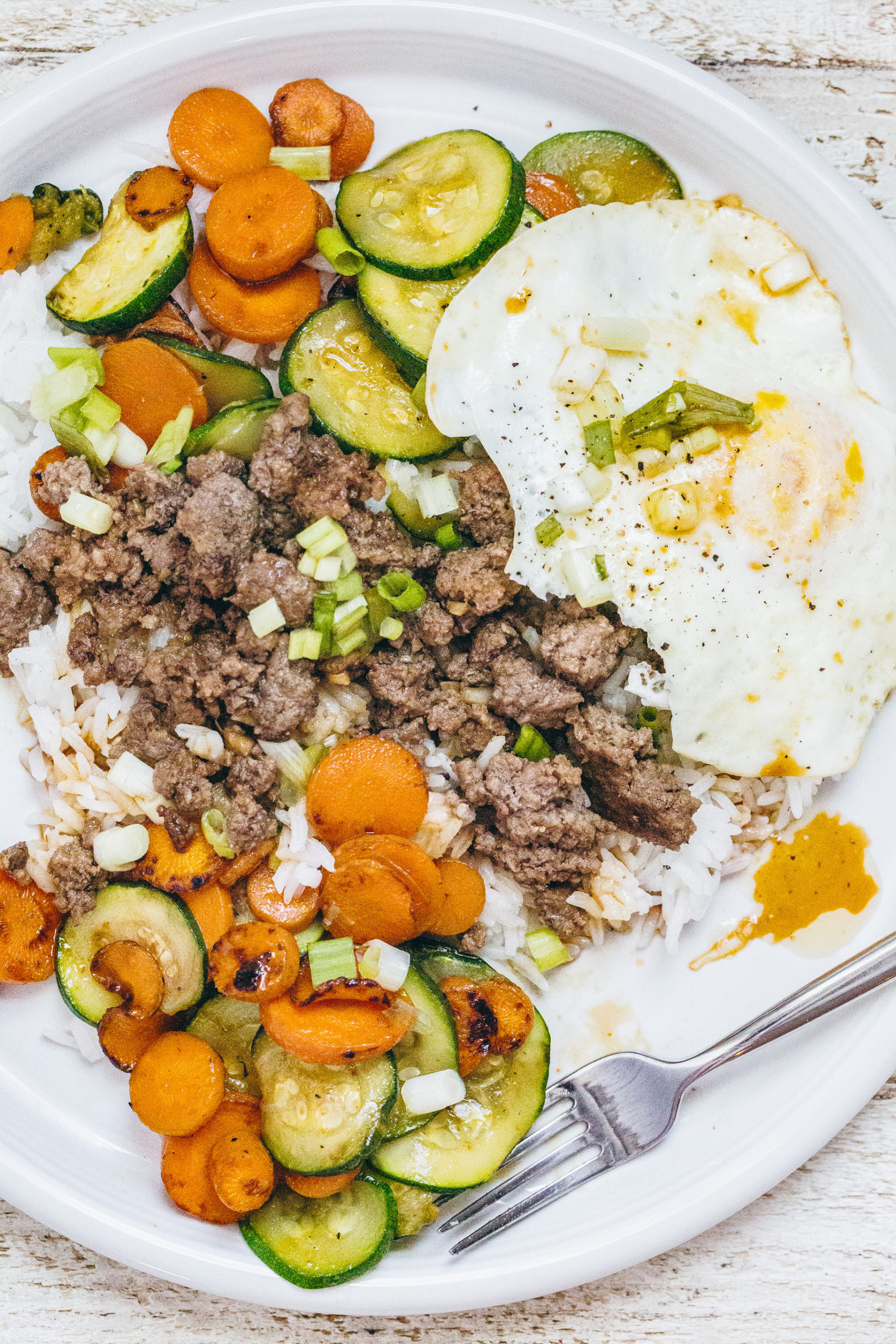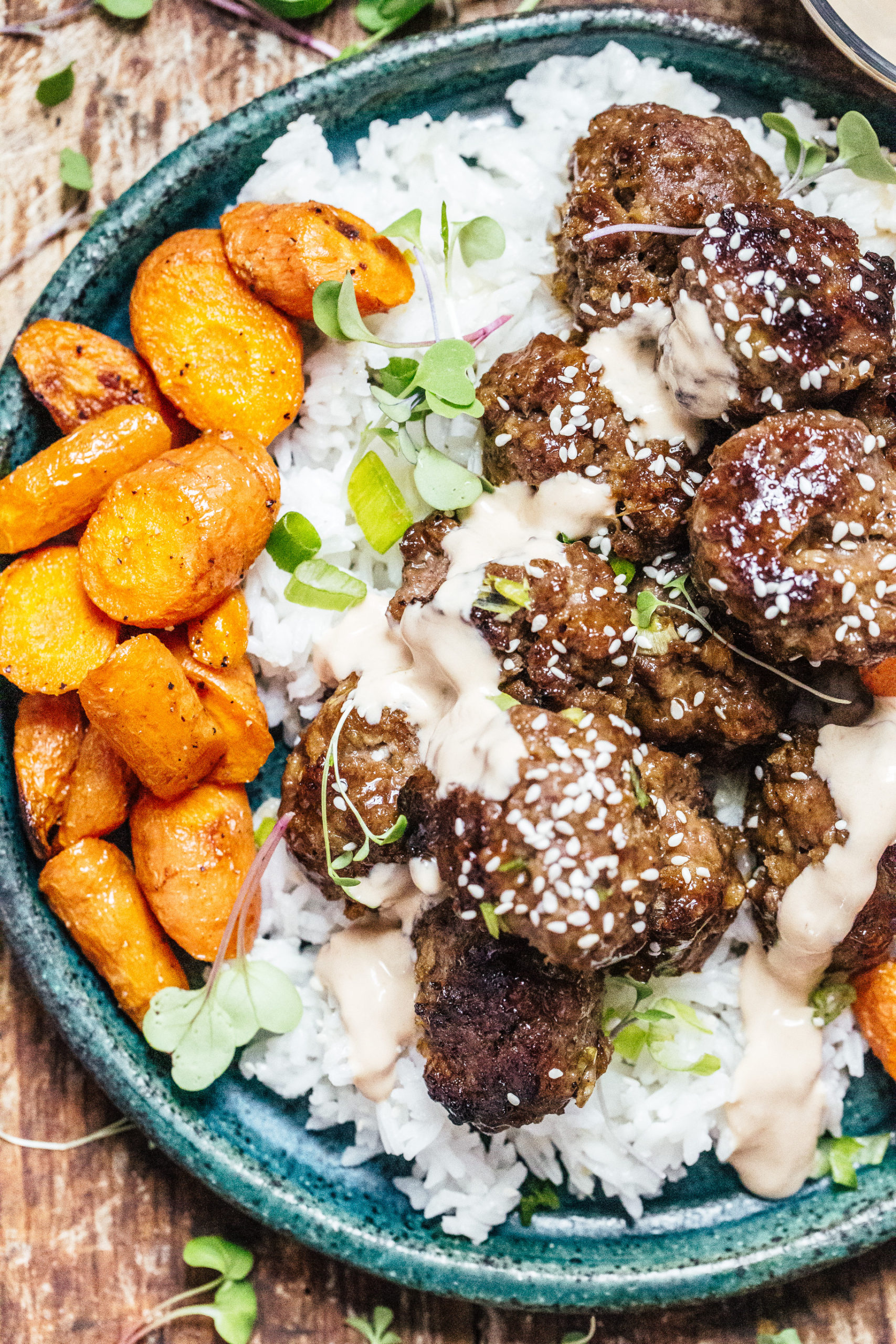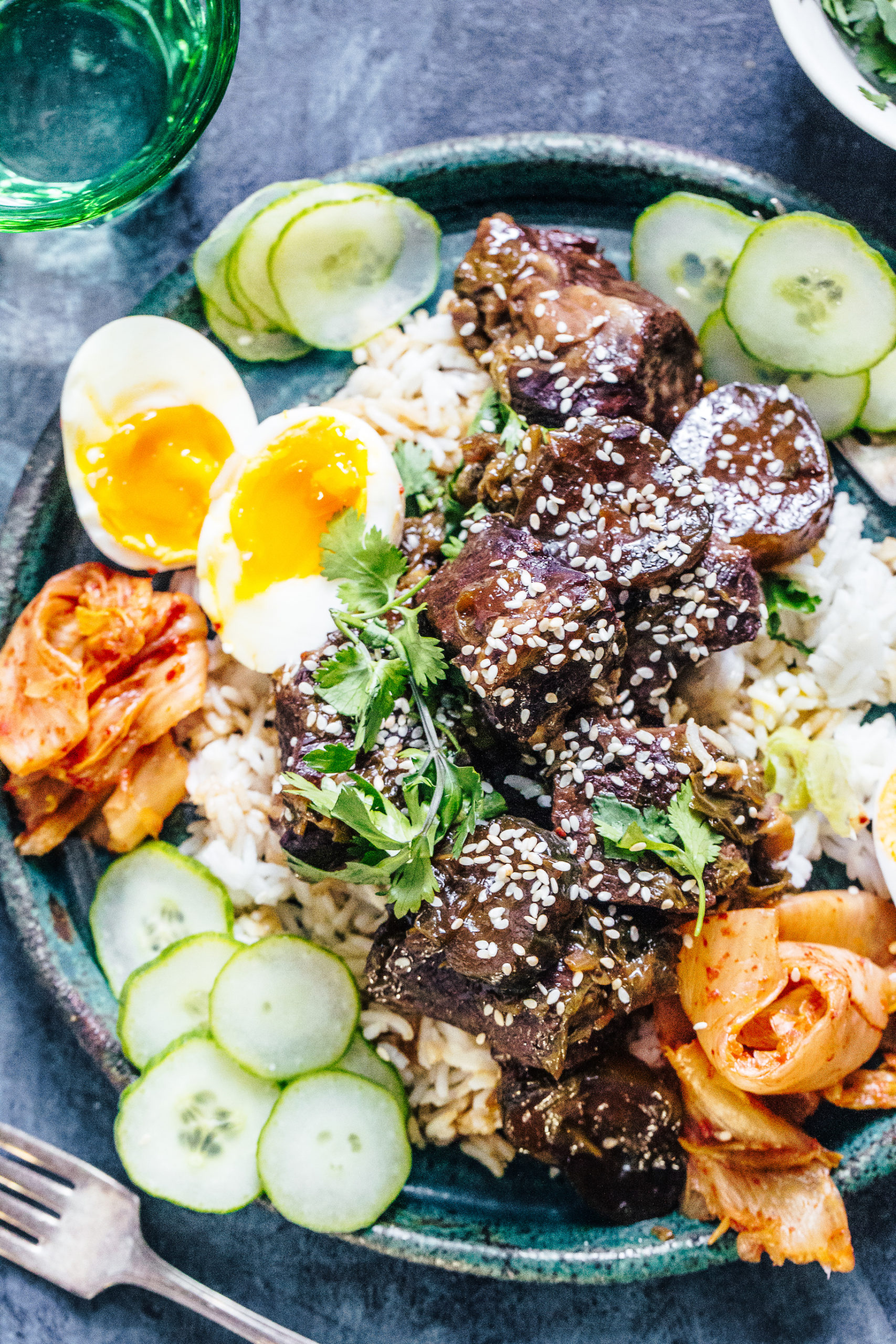
Similar to the Bulgogi Beef Meatballs I shared recently, this Crispy Ginger Beef Bibimbap recipe really just serves to sate my near constant craving for Korean food – an absolute favorite of mine. I have friends who spent years teaching in South Korea when we were in our twenties, and after listening to them speak about their culinary adventuring while they were there, I myself developed a true interest in Korean cuisine – its flavors techniques, and most iconic dishes.
Today’s recipe is actually based off of a version of authentic Bibimbap that was prepared for my husband and me years and years ago, by the wife of a former boss of his. They made a big spread of gorgeous Korean food and shared a bit about the cuisine with us. I first learned of Bibimbap then, and asked if there were any quick or simplified ways to enjoy some of the classic grilled meat-based Korean dishes (we didn’t have a grill at the time, and actually still don’t). Dr. Ko suggested using ground meat in place of the whole cuts, and hence, this version of Beef Bibimbap was born.
Thanks, Dr. Ko.

What is Bibimbap?
In it’s simplest explanation, Bibimbap is a Korean rice dish, the term, “bibim,” translating to “mixing rice” and “bap” referring to rice as well. This classic dish is served as a rice bowl, essentially, where warm white rice is topped with seasoned vegetables or “namul,” (here, we’ll do simply sautéed carrots and zucchini), kimchi, gochujang, as well as other flavorings and seasonings, such as soy sauce and doenjang (a super flavorful thick brown paste made from fermented soybeans and salt, like miso). Sliced meats and raw eggs are typically added as well, just a the end, the heat from the bowl serving to cook it gently.
What is the difference between Bulgogi and Bibimbap?
I recently shared a simple version of bulgogi-inspired meatballs here on My Kitchen Little, and the recipe has been met with some really great reader reviews. To ensure clarity here, and to distinguish between these two beloved Korean dishes, let’s break down the key components of each.
Bulgogi: Typically made from grilled or shredded beef with vegetables. You will often see it served with some of the same accompaniments as Bibimbap, like kimchi, gochugang, namul, and doenjang.
Bibimbap: The rice really takes center stage in Bibimbap, as it acts as a bed for the accoutrements and building blocks of flavor that combine to make the dish. These rice bowls usually do have the addition of a raw egg, which is dropped down into the hot bowl, just before serving, The bowls and their contents are typically hot enough to very gently cook the eggs, and the yolks provide a natural, luscious sauce for the dish as well.

How is Bibimbap Served?
Now. You’ll see in my photos here, that I’ve dished up this Bibimbap-inspired meal on plates, rather than the traditional bowls – hot stone bowls, to be exact. This really is for no reason other than that’s just what worked at the time, and for the photos. I don’t have great stoneware bowls. You can serve this recipe in bowls – which is more in line with authentic Bibimbap – or on plates. Either way, you’ll wind up with a really killer dish of food that has flavors worth singing about.
Isn’t Bibimbap served with a raw egg?
Yep. That’s usually what you’ll see, but since I served this up to both my own young children as well as a couple of neighbors – and I don’t have great stoneware bowls to help cook the raw egg after serving – I opted to fry the eggs this time. The yolk still runs down into the dish, creating a saucy, glorious eating experience, nonetheless.
What kind of meat is used in Bibimbap?
Typically beef, and you’ll see some different cuts used in Bibimbap, but I’ve most often enjoyed it with grilled flank steak. In today’s quick stovetop version (again, I don’t have a grill) we’re using ground beef and flavoring it intensely to translate the same succulent effect of the marinated grilled meats you’ll often seen piled atop a classic rice Bibimbap bowl.
The Popularity of Bibimbap
Increased travel to South Korea over the past 20 years has really put a spotlight on the country’s culture – from music and makeup to writing and of course, the incredible cuisine. This has proven true in my own life, as I’ve had many friends travel to South Korea and return with tales of their culinary exploits – thus resulting in an increased interest of my own, even though I’ve not been there myself.
Bibimbap itself is really pretty easy to make, a simply prepared dish that is quite accessible for the home cook. This simplicity of preparation and general accessibility of ingredients has also contributed to its popularity worldwide, not just in South Korea or in Korean restaurants.



What you’ll need to make this Easy Beef Bibimbap Recipe
4 servings Jasmine rice, cooked per package directions
2 scallions, thinly sliced
½ cup rice wine vinegar
2 TBSP sesame oil
1.5 TBSP sugar
4 TBSP soy sauce, divided
3 tsp. Gochujang
1 lb. ground beef
2 zucchini, sliced into thin rounds
4 carrots, sliced into thin coins
3 garlic cloves, minced or grated
2-inch piece of ginger, grated or minced
Salt and pepper to taste
4 runny-yolk fried eggs, for serving

How to make this easy Crispy Ginger Beef Bibimbap
Place ⅔ of the scallions into a small bowl and add vinegar to cover. Season with a pinch of salt and set aside to pickle.
In a second small bowl, combine the sesame oil, sugar, 2 TBSP soy sauce, and the gochujang. Stir until the sugar has dissolved.
Add a couple teaspoons of oil to a large nonstick skillet set over medium heat. Add the sliced carrots, season lightly with salt and pepper, and cook, stirring frequently, until tender. Transfer to a plate. Add a little more oil to the pan, if needed, along with the zucchini. Season lightly and cook until tender, about 3 to 5 minutes. Transfer to the plate with the carrots.
Add another couple tsp oil to the same pan, now set to med-high. Add the beef in a single layer, broken up/spread out as much as you can. Let it brown and cook almost all the way through on one side, to get it nice and crispy; takes about 4 or 5 minutes. Add the ginger and the garlic, along with salt and pepper to taste. Stir and cook just until browned all the way through. Drain excess grease from the pan.
Turn off the heat, add the remaining 2 TBSP soy sauce and stir.
To serve, pile some of the hot cooked rice into bowls or onto plates. Top with some gingery beef, the veggies, a lightly fried egg, pickled and fresh scallions, and the sweet sesame sauce. Kimchi is highly recommended as a condiment as well (of course).

If you like the looks of this Crispy Ginger Beef Bibimbap, you might also enjoy:

Bulgogi Beef Meatballs with Roasted Carrots

Crispy Ginger Beef Bibimbap with Sweet Sesame Sauce
A delicious Korean-inspired rice bowl filled with seasoned, crispy ginger-garlic beef, sautéed veggies, pickled scallions, and runny fried eggs. A fast sesame-Gochujang sauce seals the deal.
- Yield: Serves 4
Ingredients
- 4 servings Jasmine rice, cooked per package directions
- 4 scallions, thinly sliced
- 2/3 cup rice wine vinegar
- 2 TBSP sesame oil
- 1.5 TBSP sugar
- 4 TBSP soy sauce, divided
- 2 tsp Sriracha
- 1 lb. ground beef
- 2 zucchini, sliced into thin rounds
- 4 carrots, sliced into thin coins
- 3 garlic cloves, minced or grated
- 2-inch piece of ginger, grated or minced
- Salt and pepper to taste
- 4 runny-yolk fried eggs, for serving
- Toppings suggestions: kimchi, gochujang, chopped scallions and/or cilantro
Instructions
- Place ⅔ of the scallions into a small bowl and add vinegar to cover. Season with a pinch of salt and set aside to pickle.
- In a second small bowl, combine the sesame oil, sugar, 2 TBSP soy sauce, and 2 tsp gochujang (or more, to taste). Stir until the sugar has dissolved.
- Add a couple tsp oil to a large skillet (preferably nonstick) set over medium heat. Add the sliced carrots, season lightly with salt and pepper, and cook, stirring frequently, until tender. Transfer to a plate. Add a little more oil to the pan, if needed, along with the zucchini. Season lightly and cook until tender, about 3 to 5 minutes. Transfer to the plate with the carrots.
- Add another couple tsp oil to the same pan, now set to med-high. Add the beef in a single layer, broken up/spread out as much as you can. Let it brown and cook almost all the way through on one side, to get it nice and crispy; takes about 4 or 5 minutes. Add the ginger and the garlic, along with salt and pepper to taste. Stir and cook just until browned all the way through; about 30 seconds more. Drain excess grease from the pan.
- Turn off the heat, add the remaining 2 TBSP soy sauce and stir.
- To serve, pile some of the hot cooked rice into bowls or onto plates. Top with some gingery beef, the veggies, a lightly fried egg, pickled and fresh scallions, and the sweet sesame sauce.
Keywords: Ginger Beef Bibimbap



